VALORANT Economy Tips, Tricks, and Examples
Shooting mechanics, utility usage, map knowledge, and team play are some aspects players think of to improve in order to rank up and get better at the game. One part that can be often overlooked is properly managing the economy.
Understanding when and what to buy, when to save, when to hunt for opponents saving will result in getting more rifle buys for your team and more saving for the other team which can be the difference between winning and losing a 13-11, 13-10, or 13-9 game.
This article will go over the basics of the economy to advanced strategies of squeezing out as many buys as possible and how to damage your opponent’s economy.
(Feel free to skip the basics sections if you understand the means of earning credits, how many credits are earned per round, and simple economic strategies such as when to save.)
The Basics: Making Money
Through the game there are a few ways to earn credits. At the end of every round you will gain a set number of credits based on the result of the round, $200 is given for a kill, and the entire attacking team will gain $300 for planting the spike.
The round result gives varying amounts, a round win will always give $3000, when saving (not dying during a round loss) gives $1000 credits, and a loss gives $1900, $2400, or $2900 depending on how many round losses occur in a row. $1900 for the first round loss of a steak, $2400 on the second loss in a row, and $2900 for the third or greater round loss in a row.
These numbers are important to know because you want to ensure being able to have a full buy as much as possible. A typical full buy consists of a rifle (Phantom or Vandal) for $2900, armor for $400 or $1000, and some utility which ranges from $0-$800 depending on Agent and leftover utility from the previous round. This makes a full buy range from $3300 to $4700 credits.
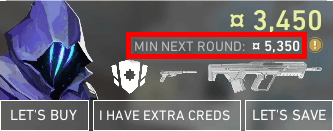
This range is very important to know to prevent overbuying and missing out on a proper buy because of overspending in a round where your team is saving. The “min. next round” value in the buy menu is very good at gauging this for you as it adds on your current loss bonus to your current amount of money minus what you currently purchased.
The Basics: How to Spend
Knowing how to earn credits is one thing, but knowing when to spend them is the more difficult part. Before getting into it it’s important to know what a “save” is. A “full-buy” which was discussed earlier is buying armor, a rifle, and utility. Meanwhile a “light buy” or “save” is purposefully buying cheaper weapons, less utility, and/or lower levels of armor to save up enough credits to full buy the following round. The final term is a “force buy” which is buying as much as your team can knowing that if you lose you will definitely have to light buy the next round.
When it comes to saving or full buying an important rule that should be generally followed is to “buy with your team”. This general rule of thumb is to save, and buy low when your team as a whole cannot put together 5 full buys as well as perform a full buy together. This is a general rule of thumb and exceptions to this rule such as a “hero-buy” or using certain ults will be discussed later on.
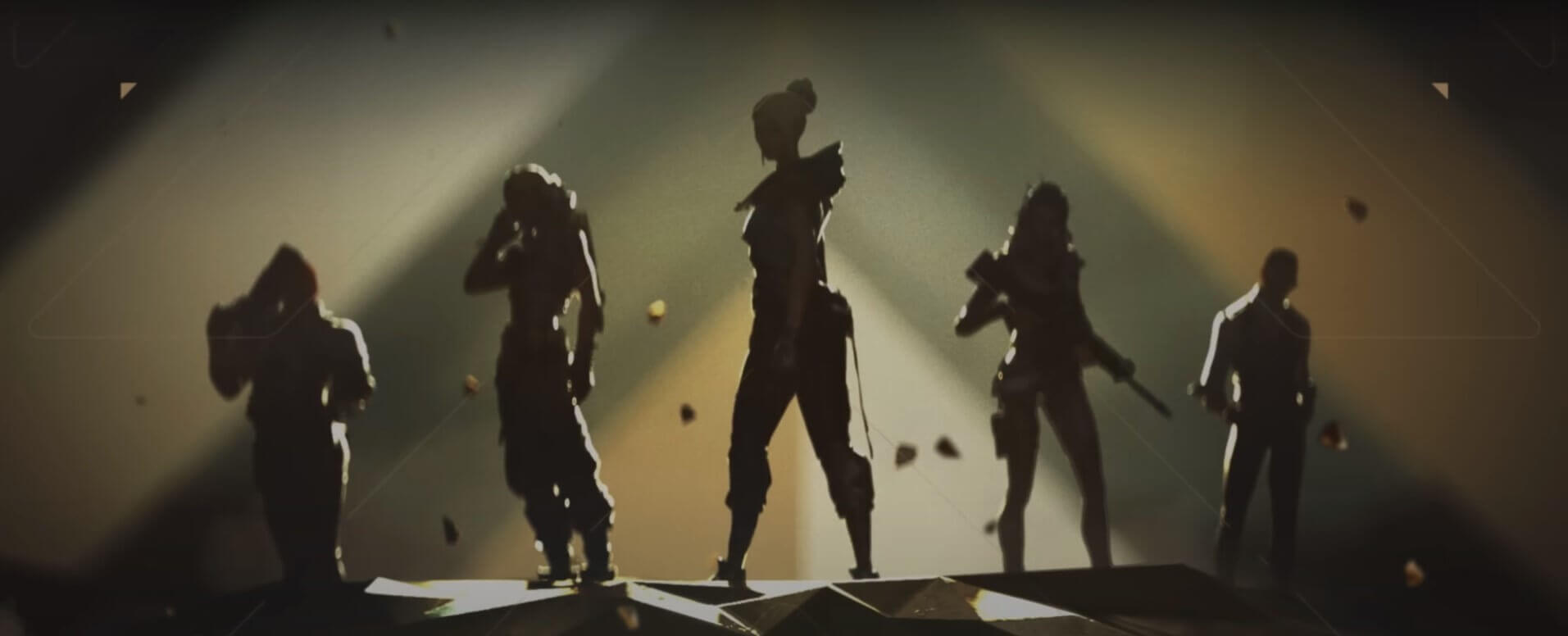
It is best to light buy when most of your team is unable to perform a full buy. When performing a light buy, pay attention to your “min. next round” value, and make sure this value is at least the $3300-$4700 range. You don’t necessarily need to be exactly in this range and can go above it to bank more credits because buying something more expensive for the heck of it for a round that your team is most likely going to lose isn’t worth being stuck with low money for future rounds.
Full buying should be done where essentially the whole team has at least that $3300. For those who don’t have enough money, a teammate can buy a weapon for someone else. This is so important in ensuring the team buys as a whole, making it more likely to win a round because everyone has a better weapon.
If a teammate cannot buy for another, and if one or maybe two people cannot full buy, a full buy can still be a good idea as those one or two players can buy a Judge to effectively hold a close angle or buddy up with a player with a rifle and play for a trade or pick up their buddy’s weapon.
This is why each player’s money should be viewed as a collective amount rather than individual values. This is a good viewpoint to have when buying for others to get everyone a full buy or to buy others when the round will bring you to the credit cap of $9000, as any credits that would have been earned beyond that is lost, and buying a teammate with less money will then result in no dead money because of the cap.
That’s it for the basics, let’s get into more intricate details.
Pistol Rounds
The first three rounds of a half are unique in terms of economy. The first round typically calls for utilizing as much of the $800 you start with except for when trying to save for an Operator early on.
The second round buy is dictated by the first round’s result and if the spike was planted. If your team won the first round it is best to buy up to give yourself the best odds of winning the next while the opposing team will most likely save for the third round.
There are a few things to buy here; a Bulldog or rifle (buying a rifle is very easy to do so when attacking and planting the spike) to carry into the third round to rival the enemy team’s full buy, a mid tier gun like a Spectre, or a great option is a Marshall as it can kill with a body shot to enemies without armor.
Then take what is leftover of these weapons into the third round which is treated as a “bonus” where the team saves up for the fourth. A less common alternative strategy utilized in pro play is to have a player or two not buy in the second round, and utilize a leftover pistol from the first round. What this does is allow this player to buy in the third round to potentially break the other team’s economy on a win and pick up a fallen teammate’s weapon to utilize the rest of the round and hand off for the bonus round.

On a first round loss the most common strategy is to save and buy in full for the third round.
There are a few alternatives; the first being to “force” buy and go all in to try to win the round which is a big risk-reward play and better to do on offense and overwhelm one site, to buy something small such as a Marshall or Sheriff and then buy full in the third round which is possible with money from first round kills and/or planting the spike (which is what EG did in the picture above), and the final is to save in the second and buy light armor in the third round to get another buy in the fourth round if the third is lost.
Buying light armor is something that has become extremely common in the pro scene due to its effectiveness, and there will be a section later on discussing this in further detail.
As mentioned before, if trying to buy an Operator early on only buy $400 worth of stuff in the first two rounds and you will be guaranteed at least $4700 by the third round. This is a very specific buy that is an exception to the vast majority of scenarios.
When to Save
When saving you’ll get a flat $1000 and keep whatever you had on you into the next round. Saving is a consideration when there is little to no chance to win the round.
When saving you forfeit whatever the loss bonus would be. This is one aspect to take into account when saving, and if you want to think about as little as possible when saving this is what you should consider: Is the $1000 dollars and armor+weapon worth more than what you can get with the current loss bonus?
If you have light armor, a Vandal, and won the previous round, then most likely saving the $3300 worth of equipment and the $1000 bonus is better than the $1900 from losing and the potential extra money from a few kills.
In general, this is why saving a low value weapon is not worth it as you will net lose out on money. In this case either die to an enemy or the spike explosion to get the full loss bonus. It is also important to note your loss bonus, as weighing a save against a $1900 loss bonus is very different than a $2900 loss bonus. Now this is saving at its most basic level, when considering saving at a higher level there is a lot more that goes into it.
The other things to consider are your team’s economic state, the opponent team’s economic state, rounds remaining, and the ultimate economy.
The easiest to think about is your team’s economic state. If your team has a lot of money, there isn’t much use in saving the weapon. This is because you can buy the next round, and the potential damage to the opponent’s economy is most likely worth it. If the weapon is expensive, such as an Operator and/or your team has limited money it is most likely worth the save. If your team is in the middle of the road in terms of economy, and can barely put together a full buy the next round, saving the weapon will be up to the other mentioned factors.
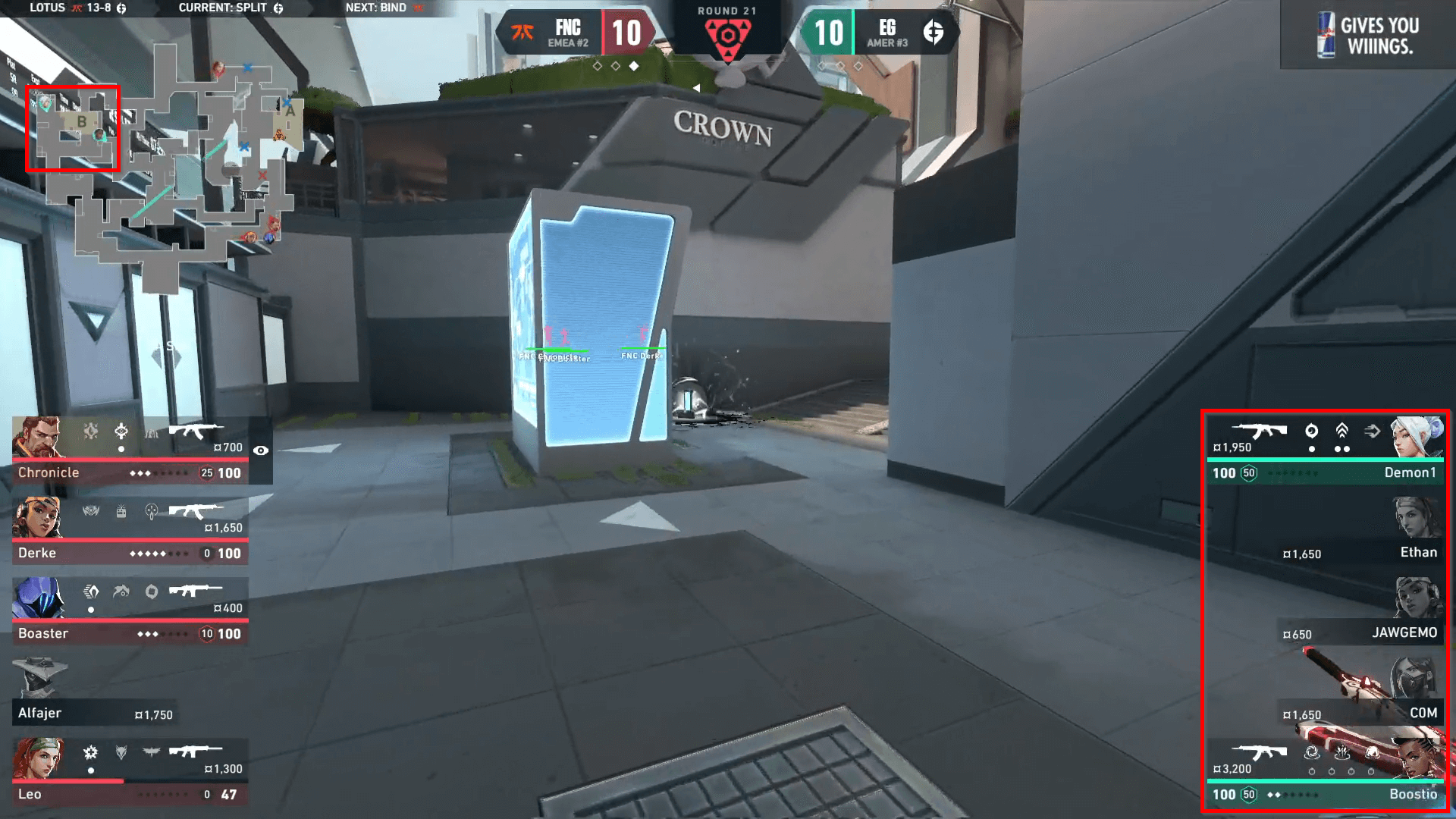
Ultimates are part of the economy too. The ultimate economy plays a role in the decision to save because an ultimate point is given for a kill or a death from a player. Ultimates are very important in the game, and deciding to go for a defuse against the odds can impact the next round with ultimate points.
Saving or dying to the spike explosion will prevent these ultimate orbs from being given, and it is important to note that dying to the spike will give you the loss bonus rather than the $1000 from saving. If you are near ultimate, and you are playing an agent with a big impact ultimate such as Killjoy, Sova, etc., then going for it in that “barely can buy the next round” scenario can be worth it.
If the other team has someone close to an impactful ultimate it may be best to avoid giving them the final bit to charge their ultimate. This goes hand in hand with the strategy of having a player with a nearly charged and/or high impact plant or defuse the spike when possible as well as fight enemies who are trying to save or have worse weapons to try to get them easy ultimate points.
The final consideration of ultimate points is when it comes to Jett and Chamber as their ultimates are a free weapon for that round. When playing these agents, they can use their ultimate to help swing a low buy in your favor, save up for an Operator the round after next, or buy a teammate a weapon with their leftover money.
The amount of rounds remaining is important because there is less of a point in trying to build up your economy the fewer rounds that are remaining. Take into account the amount of rounds remaining when forcing or saving to consider how many of those rounds you are able to buy. This also plays into when the game is about to be over. If the opponent team has 12 rounds, keep on force buying to extend the game.
The opponent’s economy plays a big part in the decision to save as hurting the enemy economy is just as important as upkeeping your own. If the enemy has low money it is worth either playing out the round despite the low odds of winning or playing for exits to take weapons away from the enemy, and force them to spend money on new weapons.
Playing for exits consists of positioning yourself in a spot to pick off enemies as they are leaving the site to avoid the spike explosion. When deciding if it is worth hunting down an opponent it comes down to their economy and the current game state, which is what the next section is on.
When to Hunt
This section is on when it is the proper time to try to get kills in a round that is essentially lost to hurt the other team’s economy. The most basic principle of this is the inverse of when to save.
If the player is netting money from what they are carrying into the next round relative to their post round bonus, it is worth trying to take their weapon away. The same concepts apply as the saving scenario where the rounds remaining, total economy on both sides, and ultimate economy play a part.
For example there is no need to chase down an Operator who is saving if your economy is on the edge of being broken and that player has $7900 with 3 rounds to go. They’ll just buy an Operator the next round and carry on while you risk breaking your own economy.
Ultimates play into this too as mentioned during the previous section. For example if you have a teammate who is playing an agent with a high impact ultimate that is almost charged, have them hunt for opponents if it won’t impact the economy too negatively.
Even a death gains an ultimate point, and agents with high impact ultimates can be used to hunt opposing players when they are saving or even be prioritized to kill enemies with weaker weapons to build up a high impact ultimate. This can be seen in the picture below where Raze is hunting down the players with pistols to earn Ultimate points.
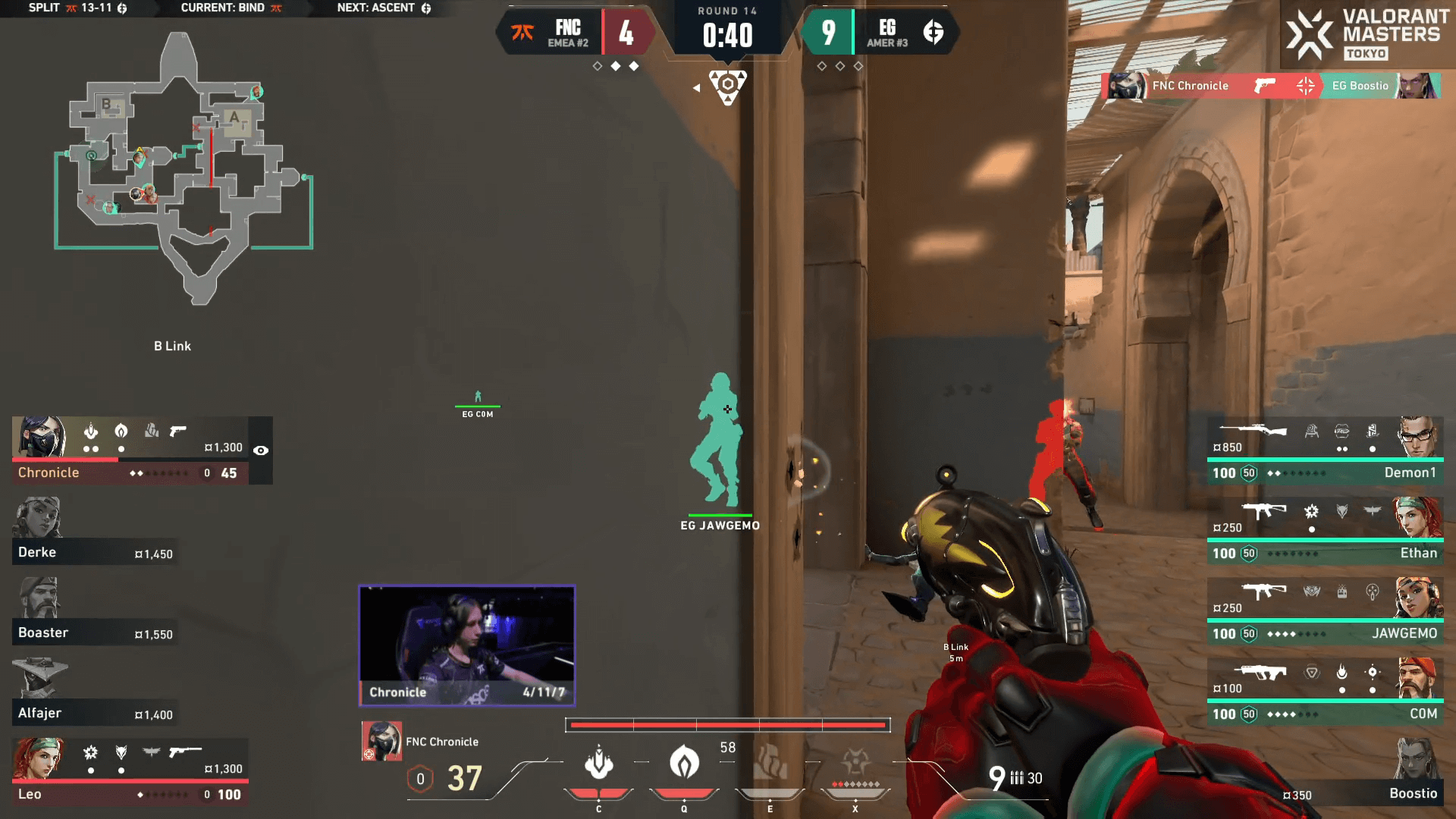
As mentioned earlier, don’t think of your money individually, think of the team’s money as a whole. This also applies to the enemy. When 3 or more players survive into the next round after a win in which the team has rifles, the team nets money.
Not only do they net money, but it essentially guarantees a buy the next round as the two remaining players can either buy for themselves or have any of the 3 players who survived last round buy for them. This is a good breaking point to decide on playing for exits.
If you get traded out when playing for exits and bring the enemy team down from 3 to 2 players remaining that’s a big win. In this case it’s still worth it even if you and your teammate cannot buy the next round, because that weapon you’d save otherwise would most likely be the only rifle amongst your team, so you might as well try to damage the enemy economy to lessen their ability to buy the next round.
It is also important to remember the loss bonus when hunting enemies who are saving. If the enemies saving are about to lose their first round in a row, the weapons are more valuable to have as they will only get $1900 from the loss.
The difference between a save and a death is $1000 and a rifle versus $1900 which is massive. With a smaller loss bonus, a save is more valuable which should promote hunting an enemy if they are saving with a smaller loss bonus.
When to Buy Light Armor
In the current state of the game Light Armor is so strong that it is worth having its own section over. Light Armor gives 25 hit points for $400 while Heavy Armor gives 50 hit points for $1000. Light armor gives more hit points per credit spent which is odd against typical consumerism in general.
The difference between light armor and heavy armor is $600 which can add up over rounds to build up your economy to get more total buys, or even be the difference between buying and saving the next round in case of a loss. This is at the cost of having 25 fewer hit points though.
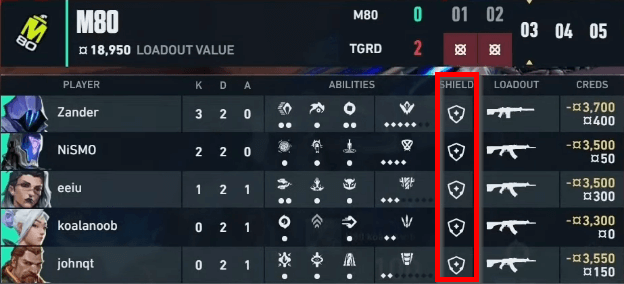
In many scenarios these 25 hit points don’t make much of a difference if you think about it. The chart below shows various scenarios of damage taken and the result based on wearing heavy or light armor. When playing against the Vandal or Operator, there is no difference between light and heavy armor, and the Phantom only has a difference between the two at 15-30 meters.
This supports the use of light armor as the odds of it being the difference between living and dying because of the 25 hit points difference is low.

Take a note of the Spectre though. Lower damage weapons this does make a difference, so be cognizant of when the enemy is on a lower buy, as the 25 hit points can make a difference.
The other thing to note is that when your economy is in a good place, you should be buying heavy armor as the $600 credits won’t break your economy, and this strategy is more so for scenarios in which the game is very back and forth as the loss bonus resets to $1900 for each team or your team is losing more so than winning.
An example of the strength in this strategy is when losing a pistol, and buying the third round. Say you saved completely in the second round and only had one in the first two rounds, you should have $4500 credits.
If you buy heavy armor, a rifle, and $400 worth of utility and lose the round you will have a min credit amount of only $3100, and will need to light buy the next. If you were to instead buy light armor, a rifle, and $400 worth of utility you will have $3700 at a minimum and can make the exact same light armor, rifle, and $400 utility buy once again without even considering money from kills or spike plants.
Here is an example scenario where the light armor strategy gives an extra buy, and gives two chances at a round win which will start to get your team’s economy rolling rather than it being immediately broken if losing the third round with heavy armor.
The last thing to know about light armor is that the golden rule of “buy with your team” still applies. If you are buying light armor and able to fully buy again, but teammates aren’t and they are forced to save there is little value in it. Comm with your team to try it out, as it works best if the team does it collectively.
Exceptions to the Rule
There are agents and game states that will change up how you play certain rounds. For instance, if the score is 12-11 and you only have $3100, force buy as much as you can because that round needs to be won and money is reset if the game goes to overtime.
If the other team is on game point, always force. If it is the final round in a half, force. And if you are on the borderline of light buying or forcing in the second round, just force as a win will make it such that you have a higher buy in two rounds, rather than guaranteeing one throw away light buy round.
Jett and Chamber are agents that are exceptions to the rule because of their ultimates. They each get a free weapon which allows them to do one of the following actions to assist in the economy and squeeze in extra full buys:
- Use ultimate, and buy a teammate who is unable to afford a weapon with remaining credits
- Buy only armor (and maybe a cheaper weapon) and save the $2900 from the current round to build up economy in general or purchase an Operator in a subsequent round
- Try to get a kill with ultimate and have a teammate pick up the enemy’s gun
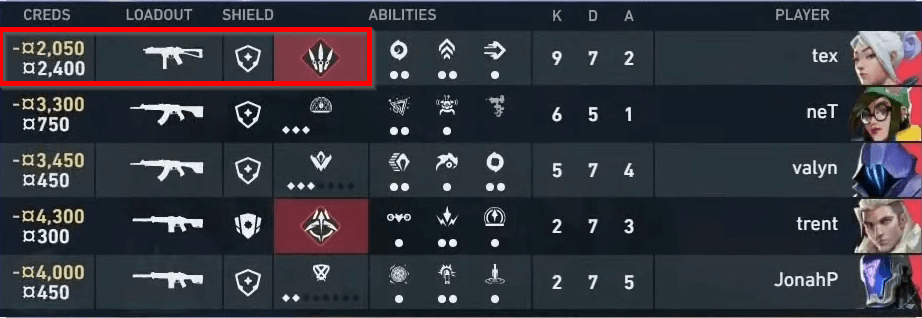
This last point is very similar to the final exception and that is a “hero buy”. This scenario is having one or two players with excess money buying a rifle with the intention of them getting a kill or a trade, and a teammate with a cheaper weapon being able to pick up the fallen enemy’s weapon to snowball the round.
Implement this strategy with the buddy system to have the player with the rifle trade out a teammate with a cheap weapon or if the player with the rifle dies, it can easily be retrieved to upgrade a teammate’s lower buy.
Predicting Buys and Enemy Strategy
Now that you know all the ins and outs of when it is best to make particular types of purchases, you can use this info to not only make the best economic decisions for yourself, but use it to better predict what your enemy will buy.
With the knowledge of what your enemy is most likely going to buy, you can then infer how they may play the next round.
It is very important to view the enemy credit amounts and ultimate points when going into a round. There are 4 things to look out for:
- >$4700: An enemy can potentially have an Operator
Clear common Operator spots with utility or jump peek to check for an Op - $3300-$4700: Enemy will most likely have a rifle if the majority of them is in this range or higher
- $1850-$3300: Enemy has a higher chance of using a Judge or another close range weapon
- Carefully clear close angles or avoid them altogether
- For example, if playing Bind, be cautious of Hookah and U Hall as these are common spots for a Judge to play
- An enemy can buy a Judge and buy the next round with the following equation where X is their current amount of money and L is the amount of losses they’ve had in a row (2 max to equate to 3x loss bonus): If 3300 < 50 + X + 500*L
- E.g. If an enemy has only lost the previous round and has $2800 credits they can buy a Judge and full buy next round (3300 < 50 + 2800 + 500*1 = 3350)
- Jett is at 6/7 Ultimate Points or Chamber is at 7/8 Ultimate Points and the enemy team has low money: There is a very high chance the opposing team will try to get one of these agents an Ultimate Orb
- Play aggressively around the Ultimate Orbs to take fights against lower cost weapons and avoid the opposing Jett or Chamber to get the orb and snowball the round, or when on offense quickly hit the opposite side of the map to fight against the weaker side
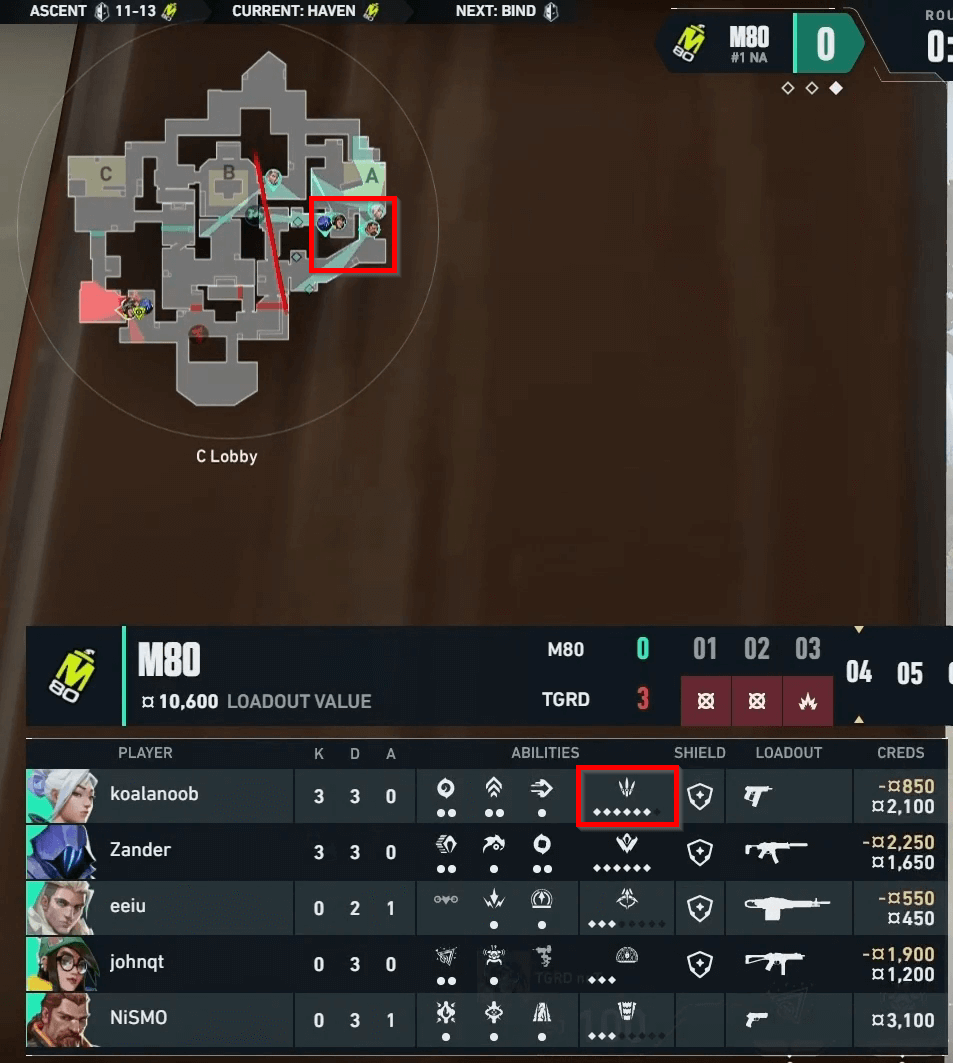
In the picture above, you can see M80 group towards A Site to secure the defensive sided Ultimate Orb to get their Jett the final Ultimate point for Blade Storm. The Guard make a great pre-round read here, and all go C Long for a fast hit.
They do this by recognizing that M80 has a weaker buy (indicates a higher likelihood of a stack) and their Jett has 6/7 Ultimate points (indicates a good chance multiple players will be utilized to grab the defensive sided orb).
In response to this the Guard go to the opposite side of the map where M80 will most likely play very light or not at all, and they end up getting a free spike plant with no opposition.
Conclusion
That was a lot of information, but even applying the surface level of this can help plan out better buys. Here are some general tips to take away:
- Full buy and light buy as a team
- Think of your money as a collective amongst the entire team
- Pay attention to the enemy team’s money and Ultimates to predict what they will buy and how they will play the round
- Try to take away enemy guns if their collective money is low, especially if they have 3 people remaining
- Try out buying light armor with your team to squeeze in extra rifle rounds
Good luck in your games to come and hopefully these tips lead to fewer eco rounds.
For profile stats, agent lineups, and more, head to the Mobalytics site for VALORANT.
 Download APP
Download APP Collapse
Collapse


